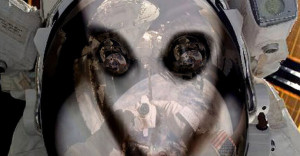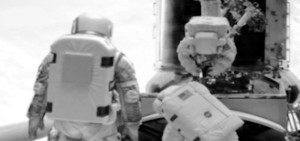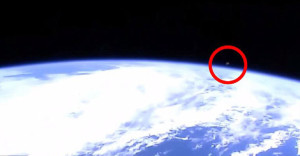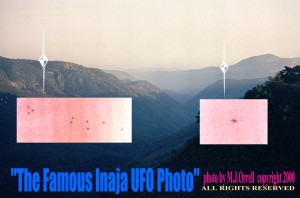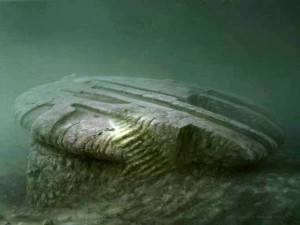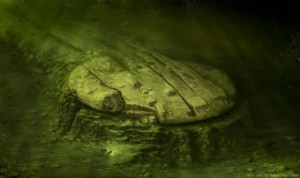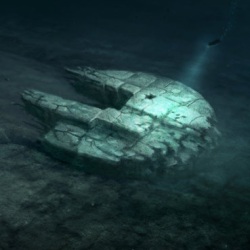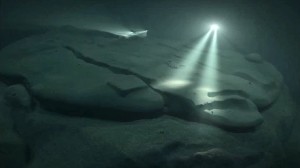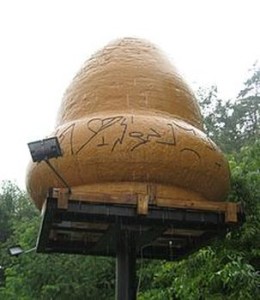 The Kecksburg UFO incident occurred on December 9, 1965, at Kecksburg, Pennsylvania, USA. A large, brilliant fireball was seen by thousands in at least six U.S. states and Ontario, Canada. It streaked over the Detroit, Michigan/Windsor, Ontario area, reportedly dropped hot metal debris over Michigan and northern Ohio, starting some grass fires and caused sonic booms in Western Pennsylvania. It was generally assumed and reported by the press to be a meteor after authorities discounted other proposed explanations such as a plane crash, errant missile test, or reentering satellite debris.
The Kecksburg UFO incident occurred on December 9, 1965, at Kecksburg, Pennsylvania, USA. A large, brilliant fireball was seen by thousands in at least six U.S. states and Ontario, Canada. It streaked over the Detroit, Michigan/Windsor, Ontario area, reportedly dropped hot metal debris over Michigan and northern Ohio, starting some grass fires and caused sonic booms in Western Pennsylvania. It was generally assumed and reported by the press to be a meteor after authorities discounted other proposed explanations such as a plane crash, errant missile test, or reentering satellite debris.
The Incident (as reported)
However, eyewitnesses in the small village of Kecksburg, about 30 miles southeast of Pittsburgh, claimed something crashed in the woods. A boy said he saw the object land; his mother saw a wisp of blue smoke arising from the woods and alerted authorities. Another reported feeling a vibration and “a thump” about the time the object reportedly landed. Others from Kecksburg, including local volunteer fire department members, reported finding an object in the shape of an acorn and about as large as a Volkswagen Beetle. Writing resembling Egyptian hieroglyphics was also said to be in a band around the base of the object. Witnesses further reported that intense military presence, most notably the United States Army, secured the area, ordered civilians out, and then removed the object on a flatbed truck. At the time, however, the military claimed they searched the woods and found “absolutely nothing”
The Tribune-Review from nearby Greensburg had a reporter at the scene; the headline in the newspaper the next morning was “Unidentified Flying Object Falls near Kecksburg — Army Ropes off Area”. The article continued with, “The area where the object landed was immediately sealed off on the order of U.S. Army and State Police officials, reportedly in anticipation of a ‘close inspection’ of whatever may have fallen… State Police officials there ordered the area roped off to await the expected arrival of both U.S. Army engineers and possibly, civilian scientists.” However, a later edition of the newspaper stated that nothing reportedly had been found after authorities searched the area.
The official explanation of the widely seen fireball was that it was a mid-sized meteor. However speculation as to the identity of the Kecksburg object (if there was one — reports vary) also range from it being an alien craft to debris from Cosmos 96, a Soviet Space Probe Intended for Venus but never left the atmosphere.
Similarities have been drawn between the Kecksburg incident and the Roswell UFO incident, leading to the former being referred to as “Pennsylvania’s Roswell.”
Scientific articles
Several articles were written about the fireball in science journals. The February 1966 issue of Sky & Telescope reported that the fireball was seen over the Detroit-Windsor area at about 4:44 p.m. EST. The Federal Aviation Administration had received 23 reports from aircraft pilots, the first starting at 4:44 p.m. A seismograph 25 miles southwest of Detroit had recorded the shock waves created by the fireball as it passed through the atmosphere. The Sky and Telescope article concluded that “the path of the fireball extended roughly from northwest to southeast” and ended “in or near the western part of Lake Erie”.
A 1967 article by two astronomers in the Journal of the Royal Astronomical Society of Canada (JRASC) used the seismographic record to pinpoint the time of passage over the Detroit area to 4:43 p.m. In addition, they used photographs of the trail taken north of Detroit at two different locations to triangulate the trajectory of the object. They concluded that the fireball was descending at a steep angle, moving from the southwest to the northeast, and likely impacted on the northwestern shore of Lake Erie near Windsor, Ontario.
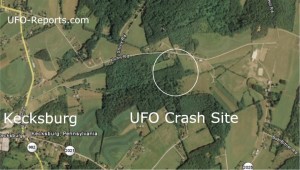
Map of the area.
The JRASC trajectory was at nearly right angles to that proposed earlier by Sky and Telescope, or a trajectory that would have taken the fireball in the direction of western Pennsylvania and Kecksburg. Thus, if the calculation was correct, this would rule out the fireball being involved in any way with what may or may not have happened in Kecksburg. The JRASC article is often cited by skeptics to debunk the notion of a UFO crash at Kecksburg.
However, the JRASC article has been criticized as lacking any error analysis. Since the triangulation base used by the astronomers in their calculations was very narrow, even very small errors in determination of directions could result in a very different triangulated trajectory. Measurement errors of slightly more than one-half degree would make possible a straight-line trajectory towards the Kecksburg area and a much shallower angle of descent than reported in the JRASC article. It was also pointed out that the photos used actually show the fireball trail becoming progressively thinner, suggesting motion away from the cameras, or in the direction of Pennsylvania. Had the trajectory been sideways to the cameras, as contended in the JRASC article, the trail would likely have remained roughly constant in thickness.
Kosmos 96
There had been some speculation (e.g. NASA’s James Oberg) that the object in the Kecksburg Incident may have been debris from Kosmos 96, a Soviet satellite. Kosmos 96 had a bell- or acorn-like shape similar to the object reported by eyewitnesses (though much smaller than witnesses reported).
However, in a 1991 report, US Space Command concluded that Kosmos 96 crashed in Canada at 3.18am on December 9, 1965, about 13 hours before the fireball thought to be the Kecksburg object undergoing re-entry was recorded at 4:45pm.
In addition, in a 2003 interview Chief Scientist for Orbital Debris at the NASA Johnson Space Center Nicholas L. Johnson stated:
I can tell you categorically, that there is no way that any debris from Kosmos 96 could have landed in Pennsylvania anywhere around 4:45 p.m.[…] That’s an absolute. Orbital mechanics is very strict.
Recent developments
2003: Sci Fi Channel reinvestigates case
In 2003, the Sci Fi Channel sponsored a scientific study of the area and related records by the Coalition for Freedom of Information. The most significant finding of the scientific team was a line of damaged trees broken at the top leading to the site where some eyewitnesses said they saw the object embedded in the soil along with associated fresh tree damage. Furthermore, tree core samples dated the damage to 1965. This provided physical evidence that something airborne may have come crashing through the trees and landed in the woods there at the time, which would contradict the military’s official story of nothing being found. (However, one of the scientists instead suggested ice damage to the trees.) Minor soil disturbance was also found at the alleged landing site.
There was also a push for NASA to release pertinent documents on the subject. Some 40 pages of these documents were released on November 1, 2003, but were unrevealing. However, there are Air Force Project Blue Book documents indicating that a three-man team was sent from an Air Force radar-installation near Pittsburgh to investigate the Kecksburg crash. (This was also reported in some newspaper articles at the time, also that Blue Book was looking into it, but had no comment.) They reported back to Blue Book that nothing was found.
2005: NASA changes story to “Russian satellite”
In December 2005, just before the 40th anniversary of the Kecksburg crash, NASA released a statement to the effect that they had examined metallic fragments from the object and now claimed it was from a re-entering “Russian satellite”. The spokesman further claimed that the related records had been misplaced. According to an Associated Press story:
The object appeared to be a Russian satellite that re-entered the atmosphere and broke up. NASA experts studied fragments from the object, but records of what they found were lost in the 1990s.
As a rule, we don’t track UFOs. What we could do, and what we apparently did as experts in spacecraft in the 1960s, was to take a look at whatever it was and give our expert opinion,” Steitz said. “We did that, we boxed (the case) up and that was the end of it. Unfortunately, the documents supporting those findings were misplaced.
—Steitz,
Furthermore, the claim contradicts what journalist Leslie Kean was told in 2003 by Nicholas L. Johnson, NASA’s chief scientist for orbital debris. As part of the new Sci Fi investigation, Kean had Johnson recheck orbital paths of all known satellites and other records from the period in 1965. Johnson told Kean that orbital mechanics made it absolutely impossible for any part of the Cosmos 96 Venus probe to have accounted for either the fireball or any object at Kecksburg. Johnson also stated there were no other known man-made satellites or other objects that re-entered the atmosphere on that day.
Kean and others deem it highly questionable that NASA could actually lose such records. (However, this would not be a unique case for NASA; for example, the original tapes recorded during the televised Apollo 11 Moon landing were misplaced or reused.)
In December 2005, a lawsuit was filed to get NASA to search more diligently for the alleged lost records.
On October 26, 2007, NASA agreed to search for those records after being ordered by the court. The judge, who had tried to move NASA along for more than 3 years, angrily referred to NASA’s previous search efforts as a “ball of yarn” that never fully answered the request, adding, “I can sense the plaintiff’s frustration because I’m frustrated.”
During the hearing, Steve McConnell, NASA’s public liaison officer, admitted two boxes of papers from the time of the Kecksburg incident were missing. Stan Gordon, principal investigator of the Kecksburg incident for several decades, stated “I have no doubt the government knows a lot more about this than it has revealed to the public.”
In 2008 space writer James Oberg opined that NASA was unlikely to possess any such documents since, in his view, it was highly likely that the supposed NASA team who investigated the site were in fact Air Force personnel who identified themselves as NASA personnel, something regularly done by military personnel in civilian clothes during the 1960s. He further suggested that Leslie Kean’s lawsuit was no more than a “publicity stunt” for the benefit of Kean’s employers.
In November 2009, Leslie Kean filed a report on the results of the NASA search. Documents were still missing or reported destroyed and little of interest was turned up relevant to the Kecksburg case. Of particular interest was a missing box of “fragology” files, reported destroyed, related to recovery and examination of space debris. Kean said the missing files could be due to a number of reasons, including a poor filing system, misplaced records or records filed outside of the parameters of the search, deliberately concealed records, perhaps still classified, files removed by NASA employees but never returned (one such individual was named), files that were indeed destroyed as reported, and archivists unfamiliar with what was being searched for. In addition, the plaintiffs had to trust that NASA carried out the search as they reported to the court, since the plaintiffs were not allowed to examine the search materials for themselves. Despite reservations about the thoroughness or accuracy of the search, Kean said they felt they had exhausted their legal remedies and ended the lawsuit against NASA.
Kean noted that some items of interest did turn up, such as NASA’s general involvement in collecting space debris and analyzing it, including interest in sightings of lesser meteor fireball seen at about the same time. In addition, NASA sent out press releases to news agencies about these other fireballs. But NASA had nothing on the very widely reported and seen fireball associated with the Kecksburg case and issued no stories on it.
Kean also wrote that she tried to get more information from David Steitz, the NASA spokesperson who issued the surprising statement in 2005 that NASA had indeed examined debris related to Kecksburg, supposedly from a Russian space probe. But Steitz never responded. Kean was particularly interested in Steitz’s source of information to make such a statement, since he also indicated there were no surviving records and the court-ordered search also turned up no relevant records. There are also records of eye witnesses saying that they had “chipped” off pieces of the artifact.

